
|
OM Zuiko Lenses on Olympus E-1 and E-300 Cameras |

|
My other articles related to the |
|
This article has been written in co-operation with John Foster from England, a long-time Olympus user and collector, an expert on Olympus film cameras, and an author of two books on the subject. This, I believe, is a perfect symbiosis: John brings in his knowledge of the OM system, and I — familiarity with the digital technology and optics. | |
|
See also:
|
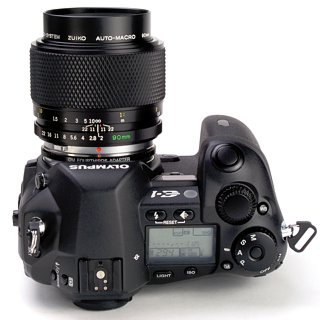
|
|
Shown: an E-1 with OM Zuiko 90 mm F/2 Macro lens.
(Photo by John Foster.) | |
|
Background Olympus has been in business of precision optical instruments since 1920, and has been making cameras since 1936. In the last decade of the 20th century, however, they withdrew from the interchangeable-lens camera market, limiting themselves to compact point-and-shoot cameras (including the still current Stylus Epic or mju-2 in Europe) and fixed-lens SLRs (sometimes referred to as ZLR, Zoom Lens Reflex). In 1972 Olympus introduced to the market the revolutionary OM-1 (which was their second SLR). This innovative camera, much smaller than any other full-frame SLR on the market, introduced the OM lens bayonet, and the Zuiko lenses made by Olympus are famous for their optical quality. Unlike other manufacturers, Olympus never developed an AF SLR system, and ceased making OM cameras in the late Nineties. Their top-of-the line OM-3Ti and OM-4Ti, however, still fetch high prices on the used market, not as collectibles but as working cameras for advanced photographers. If you have a collection of OM lenses, you may be interested in using them on your E-system camera. Even if you don't, you may be interested in acquiring one or two for special purposes. OM Lens adapters | |
|
The Four Thirds lens mount is very similar to the OM bayonet, but not compatible with it. Olympus offers an adapter, designated as MF-1 and priced at around $100. The adapter allows for use of OM-bayonet lenses (Zuiko or any other make in that mount) on any Four Thirds body. |
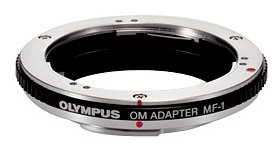
|
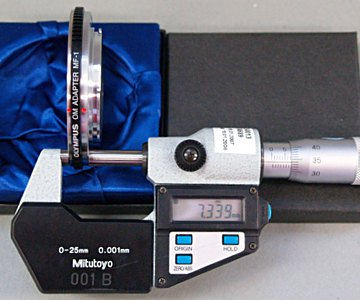
|
As you can see here, the effective thickness of the Interestingly, the difference between flange-back distances (listed here) for the Olympus OM and Four Thirds systems is 7.42 mm — 0.08 mm more and well beyond any measurement error. Therefore OM lenses mounted on Four Thirds cameras are a bit closer to the image plane than when used on OM-series cameras; this means they can be focused beyond infinity. There is nothing wrong about it, but a difference in the opposite direction would make focusing at infinity impossible. The only downside is that setting an OM lens to infinity just by turning the focus ring all the way is not quite optimal for distant subjects. |
|
Until 2005, Olympus used to offer a similar adapter, You can see that the MA-1 adapter is 7.33 mm thick, quite close to the MF-1. (Measurement and picture by Jerzy Wojewoda.) |
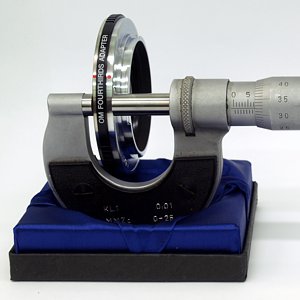
|
|
John's observations and opinions Andrzej: I already introduced to you John Foster, who not only amassed, I believe, more than 100 OM Zuiko (OMZ) lenses of all kinds and vintages, but also knows all of them by heart. Here are some of the points he made after having tried many of these lenses on the E-1 against a number of Zuiko Digital (ZD) lenses. The remainder of this section is by John; any comments by me will be clearly marked as such.
|
|
The bottom line? If you have a selection of OMZ lenses, try them, find out their strengths, note how best to use them, and keep the good ones for your E-system armory (the days of affordable primes are almost over). If you've abandoned film, it's up to you whether to cash in OM lenses that don't perform on your E-1. Maintain a selection of OMZ's for those times when a ZD zoom just can't cut it. Do not abandon your OMZ's until you've tried them in differing conditions; you might be surprised. |
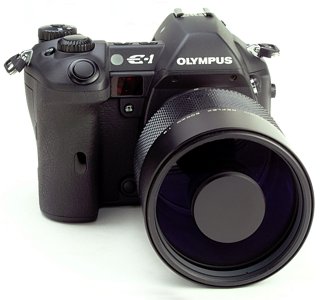
|
|
A 500 mm F/8 Mirror OM Zuiko on the E-1. This combination gives you the reach of a 1000 mm lens mounted on a film camera.
(Photo by John Foster.) | |
|
My favorites? 24mm/2.8, 40mm/2.0, 50mm/1.2, 50mm/1.8, 50mm/3.5 Macro, 90mm/2.0 Macro — the macro lenses produce stunning results on the E-1. And as an OM user, I'm not parting with any of my stable. Other resources
| |

|
My other articles related to the |
|
Olympus® is a registered trademark of Olympus Corporation.
This page is not sponsored or endorsed by Olympus (or anyone else) and presents solely the views of the authors. |
| Home: wrotniak.net | Search this site | Change font size |
| Posted 2005/01/20; last updated 2007/04/22 | Copyright © 2005-2007 by J. Andrzej Wrotniak and John Foster |